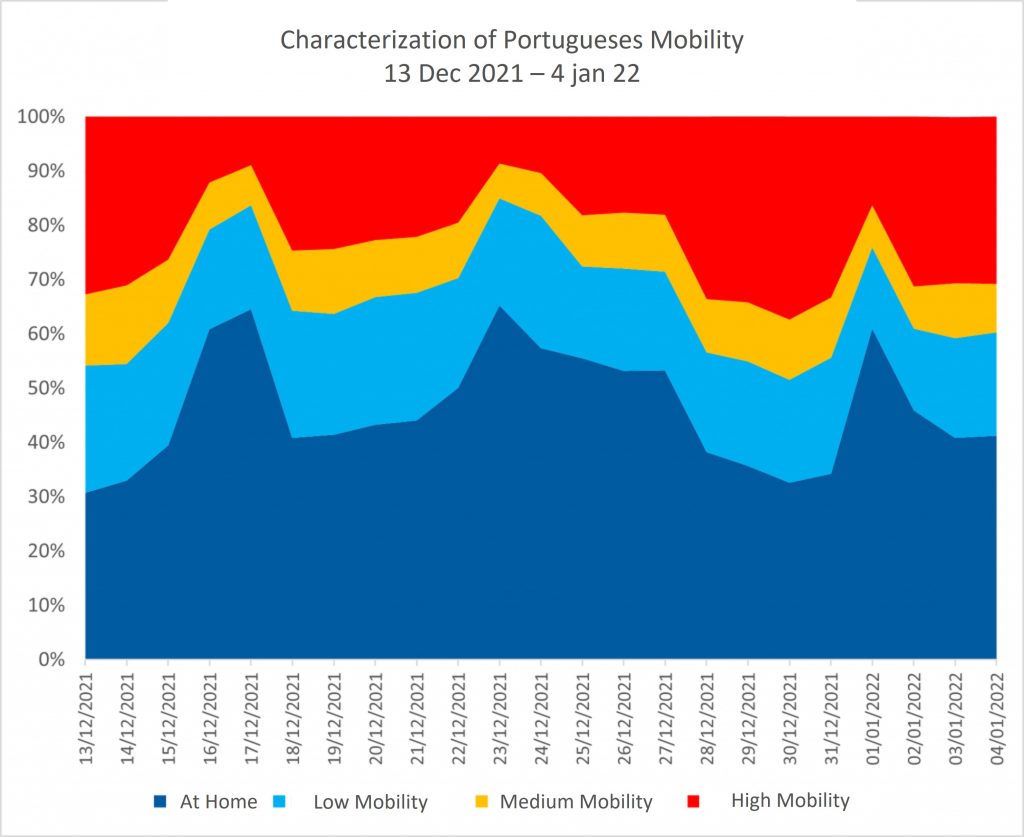The first two working days of 2022 indicate that the population is complying with the authorities’ “restraint” recommendation.
The PSE Panel study makes it possible to measure the mobility of the Portuguese, continuously in time, hour after hour. This study also assesses the level of “Home Confinement”, quantifying the number of people who did not leave their home during a given day.
We consider, for a simpler characterization of mobility, four distinct levels of mobility. They are the following: The group of people “At Home” composed of those who have not left the house more than 500 meters, being “Low Mobility” up to 10km, “Medium Mobility from 10 to 20Km and even “High Mobility” more than 20km in a day. In this way, we can reflect the mobility of the population, in the period from December 13, 2021 to January 4, 2022, as follows:

Source: PSE – Mobility Panel
Based on the information from the PSE Mobility Panel, we point to the following conclusions:
- On January 3rd, 2022 (Monday), there was a high level of population confinement of 40.9%, and it is necessary to go back to March 29th, 2021 to find a Monday with an identical value. This value is, therefore, much higher than the “normal” for an average Monday.
- The first two working days of the year (3 and 4) seem to indicate compliance by the population with the behavior of “restraint” indicated by the government, as we found that around 40% of the population remained at home on each of these days. Additionally, the PSE Mobility Index on the 3rd and 4th of January recorded an average value of 88%, that is, 12 percentage points below the reference value (pre-pandemic). In average terms, a Monday has 27% of the population without going outside, or not moving more than 500 meters, on the day.
- The PSE Mobility Index in December 2021 stood at 110% in the first three weeks, having declined to 94% in the last week of 2021. A reduction of 16 percentage points.
- In the last week of the year (which ended on January 2nd) the average daily confinement level was 39% at home. In the last ten weeks it varied between 27% and 30%.
- The 1st of January naturally had a high level of confinement, with around 61% of the population staying at home on that day, or traveling no more than 500 meters from their residence.
- On the 23rd of December there were more people at home and there was less mobility than on the 24th or 25th of December, despite being reduced mobility days.
Methodological Note:
Introduction:
This study has produced since 2019, but officially since January 2021, data that are applied, above all, to the measurement of the audience of outdoor advertising, but also to assist city councils in land use planning and mobility and transport management. And also in behavioral studies of mobility and “shopper”, for other companies and entities. Data is continuously produced, day after day.
Technical Note:
This study is the PSE panel, with continuous data collection through location monitoring and means of travel via mobile application of a panel of 2500 representative individuals of the Universe over 15 years old, residing in the regions of Greater Porto, Greater Lisbon, North Coast, Center Coast and Faro District. This study involves an APP installed on the participating sample’s mobile phones. Thus, we monitor the actual movement of the population, in each hour of the day. This study is carried out 24 hours a day. Data are obtained rigorously, via GPS and with the consent of the monitored sample. For a universe of 6,996,113 individuals residing in the regions studied, the margin of error attributable to the study is 2% for a confidence interval of 95%.




